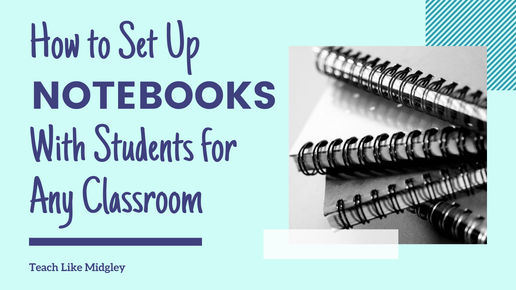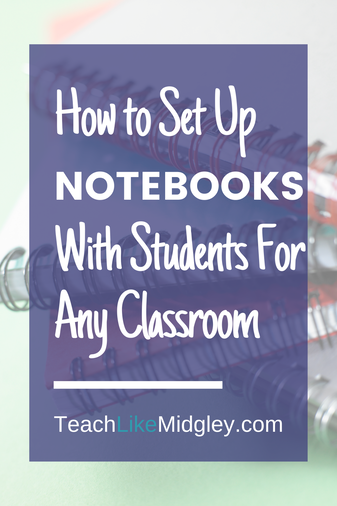How to Set Up Notebooks With Students
for Any Classroom
If you require your students to keep a notebook, then you this post is for you. Or rather, your students!
No matter if you are team Interactive Notebook or team Anti-Interactive Notebook – doesn’t matter.
Most students are not equipped with the skills to automatically know how to organize their notebook for ease of use. The fact is, if you require students to keep a notebook, they need help with organization.
No matter if you are team Interactive Notebook or team Anti-Interactive Notebook – doesn’t matter.
Most students are not equipped with the skills to automatically know how to organize their notebook for ease of use. The fact is, if you require students to keep a notebook, they need help with organization.
And that’s exactly what this post is all about. No matter if your students are in 5th grade, 9th grade, or any grade level between. It also doesn’t matter what subject you are teaching – social studies, science, ELA, or even math. You need to know how to help your students set up their notebook and use it successfully.
Why Use Notebooks
Students need time to process content. Which means they need opportunities to work with information and practice with it in different ways.
Sure, taking notes is one way they work with content. But simply taking notes does not allow students to fully process information. Students need to answer questions, write summaries, create diagrams, and track key vocabulary.
Students need space for their processing. And not on a worksheet that will be graded for correct responses. They need a space that if graded at all, is graded for effort and completeness.
Students also need to revisit their work, and have the opportunity to reflect and review, if they are to be tested on the material. And they need to be taught how to go back and use the work they’ve already completed as a study method.
The notebook is the perfect answer to all of this. Student notebooks are an ideal tool for allowing students to process information and teach them organization skills at the same time. All while serving as excellent study tools for students.
Sure, taking notes is one way they work with content. But simply taking notes does not allow students to fully process information. Students need to answer questions, write summaries, create diagrams, and track key vocabulary.
Students need space for their processing. And not on a worksheet that will be graded for correct responses. They need a space that if graded at all, is graded for effort and completeness.
Students also need to revisit their work, and have the opportunity to reflect and review, if they are to be tested on the material. And they need to be taught how to go back and use the work they’ve already completed as a study method.
The notebook is the perfect answer to all of this. Student notebooks are an ideal tool for allowing students to process information and teach them organization skills at the same time. All while serving as excellent study tools for students.
Choosing the Notebook
Now a days there are so many different types of notebooks out there, it’s enough to make your head spin. And the most important thing to realize, is that not every notebook is created equal.
Now you might be wondering why this matters – well it matters a great deal if you have students glue any type of diagram or organizer onto their page. Some notebooks are smaller than others.
Notebooks don’t always come with the same number of pages either. Which means you could have students running out of pages too soon.
Notebooks also come in wide rule or college rule, which will have a big impact if you need students to list a certain number of items on a page – not every notebook may allow this.
If your students are older, you can always set your specifications for purchase of a notebook. And if your students are younger, you may find it easier to provide students with notebooks.
In August you can often find good deals for the back to school season. I usually found notebooks for 10-15 cents apiece. For me, it was worth it. Even though I had 130+ students. If you are provided classroom funds from your district, consider using it for notebooks.
Now you might be wondering why this matters – well it matters a great deal if you have students glue any type of diagram or organizer onto their page. Some notebooks are smaller than others.
Notebooks don’t always come with the same number of pages either. Which means you could have students running out of pages too soon.
Notebooks also come in wide rule or college rule, which will have a big impact if you need students to list a certain number of items on a page – not every notebook may allow this.
If your students are older, you can always set your specifications for purchase of a notebook. And if your students are younger, you may find it easier to provide students with notebooks.
In August you can often find good deals for the back to school season. I usually found notebooks for 10-15 cents apiece. For me, it was worth it. Even though I had 130+ students. If you are provided classroom funds from your district, consider using it for notebooks.
Plan A Day For Notebook Set Up
You’ll find in my First Seven Days of School: Ancient History Lesson Plans, that there is a day dedicated to setting up student notebooks.
I use a brief PowerPoint presentation to outline my expectations for student use of their notebooks.
Then we pass out notebooks and get started with the set up. The first step is always passing out sharpies to write first and last names, along with the class period.
Next we make a pocket inside the front cover. Taking two pages, fold them over as a triangle, tape it to the cover to make a pocket. Use the pocket for important papers you want your students to keep. I use it for a booklet I created of important information which included my syllabus, rules, and a place for students to record grades and write quarterly goals with reflections.
Third, you may choose to include a title page, where students their name, teacher name, class name, and class period. I choose to allow students to decorate it with pictures of their favorite things – this allows for personalization, and a great way for them to spend any remaining time of class once we finish the set up.
Finally, you want to set up your Table of Contents Pages. Plan to have students record the date, page numbers, and title. It’s also helpful to have a column on the far left to mark the chapter.
I use a brief PowerPoint presentation to outline my expectations for student use of their notebooks.
Then we pass out notebooks and get started with the set up. The first step is always passing out sharpies to write first and last names, along with the class period.
Next we make a pocket inside the front cover. Taking two pages, fold them over as a triangle, tape it to the cover to make a pocket. Use the pocket for important papers you want your students to keep. I use it for a booklet I created of important information which included my syllabus, rules, and a place for students to record grades and write quarterly goals with reflections.
Third, you may choose to include a title page, where students their name, teacher name, class name, and class period. I choose to allow students to decorate it with pictures of their favorite things – this allows for personalization, and a great way for them to spend any remaining time of class once we finish the set up.
Finally, you want to set up your Table of Contents Pages. Plan to have students record the date, page numbers, and title. It’s also helpful to have a column on the far left to mark the chapter.
Using Student Notebooks In Class
The first few weeks of using the notebooks, you will want to do EVERY step with your students, under your document camera. Learning to use the notebook is a skill, and that takes practice. Students need you to model for them expectations, and this is most effective when they can see it.
After a while though, your students will be able to do steps on their own – like filling in their Table of Contents and setting up the page for the day’s lesson. I incorporate these steps into my Do Now tasks as part of my EASY Bell Ringers.
Before students begin their lesson tasks, whether it’s taking notes or defining vocabulary, they need to make sure the page is set up properly. This includes: page number, date, and title of the activity.
No matter what type of activity you have your students complete in their notebook, you will want to make sure you are providing clear instructions and structure. Use these 9 Strategies to Help Your Students Take Better Class Notes.
After a while though, your students will be able to do steps on their own – like filling in their Table of Contents and setting up the page for the day’s lesson. I incorporate these steps into my Do Now tasks as part of my EASY Bell Ringers.
Before students begin their lesson tasks, whether it’s taking notes or defining vocabulary, they need to make sure the page is set up properly. This includes: page number, date, and title of the activity.
No matter what type of activity you have your students complete in their notebook, you will want to make sure you are providing clear instructions and structure. Use these 9 Strategies to Help Your Students Take Better Class Notes.
Teaching Students to Revisit the Notebook
Putting the notebook together is one thing, but going back and using it is definitely another thing. Your students NEED you to teach them how to go back and reference their work. There are two main ways that I do this. At the start of every class, we do a quick review of what we have already learned. If there is a question where students get stumped, I say, “Pull out your notebook and let’s look it up!” The other way is when students are working in class and they can’t remember a particular vocabulary word or concept we’ve learned, I have them refer back to their notes and vocabulary work in the notebook.
This is probably the most important skill you can teach your students. Using their notebook helps them understand why they do the work in the first place and encourages them to become independent learners. Otherwise, what’s the point of it all anyways?
This is probably the most important skill you can teach your students. Using their notebook helps them understand why they do the work in the first place and encourages them to become independent learners. Otherwise, what’s the point of it all anyways?
Ready to Roll Materials
Now that you know how to set up notebooks with your students, you are ready to go. Your students are sure to learn valuable skills that will follow them in their academic career – you are after all, teaching them study skills and how to be successful students!
If you are looking for more goods to make it that much easier for you, then I’ve got your covered with my Interactive Student Notebook Implementation Package.
And if you want the details of how I use notebooks with ancient history, check out these blog posts:
If you are looking for more goods to make it that much easier for you, then I’ve got your covered with my Interactive Student Notebook Implementation Package.
And if you want the details of how I use notebooks with ancient history, check out these blog posts:
Let's Connect...

Welcome! I'm Hillary Midgley, a veteran 6th grade teacher.
I create educational materials and develop curriculum for other teachers. I specialize in teaching students how to learn through my Study Skills Curriculum. I have established fundamental classroom systems and structures for teachers to help them streamline their classroom. And my passion is teaching ancient history through engaging activities with foundations in academic skills. Here you will find resources on all of these topics and more. Learn more about me here.
|







